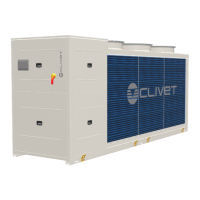Do you have a question about the CLIVET WiSAN-YEE1 65.4 and is the answer not in the manual?
General safety precautions for unit operation and personnel.
Identification and awareness of potential hazards and risks associated with the unit.
Guidance on proper unit installation, including safety and regulatory compliance.
Instructions for immediate actions in case of unit breakdown or malfunction.
Immediate actions and consequences of operating a unit in breakdown or malfunction.
Important warnings regarding the product containing fluorinated greenhouse gases.
Details on the type of refrigerant, safety class, and GWP value.
Procedures for checking unit condition and delivered materials upon reception.
Essential safety measures and equipment for handling the unit correctly.
General guidelines for installing the unit according to local regulations.
Guidance on optimal unit placement to avoid hazards and ensure functionality.
Importance of unobstructed airflow for unit performance and avoiding obstructions.
Critical water quality parameters and consequences of inadequate water.
Methods to prevent freezing in the unit and water connections.
Step-by-step procedure for starting the unit pump and filling the system.
Specifications for the power supply network, including voltage and unbalance limits.
Details of customer connections to terminal blocks, including functions and contact types.
Information on Modbus communication interface and connection.
Important attention points and safety checks before performing start-up operations.
Checklist of items to verify before powering on the unit (Unit OFF power supply).
Checklist of items to verify after powering on the unit (Unit ON power supply).
Detailed checks for the refrigeration circuit, including oil stains and pressure.
Checks for the electric circuit, including ground connection, conductors, and phase balance.
Explanation of the function of each button on the control panel.
Explanation of icons displayed on the control panel and their corresponding meanings.
Instructions for setting the operating mode and desired temperature.
Configuration and operation of the unit for domestic hot water production.
Function to display unit variables like status, temperatures, and alarm history.
Detailed list and explanations of alarm codes, including transmission and module errors.
Safety checks required for the work area before handling flammable refrigerants.
Adherence to controlled procedures to minimize risks during operations.
Monitoring the area with detectors to ensure the absence of flammable refrigerants.
Strict prohibition of any ignition sources that could cause fire or explosion.
Initial safety checks and component inspection procedures for electrical components.
Procedures for repairing sealed components, emphasizing safety and leak detection.
Guidelines for operations on intrinsically safe components in flammable atmospheres.
Acceptable methods for detecting flammable refrigerant leaks.
Procedures for safely removing and evacuating refrigerant from the circuit.
Requirements for charging operations, including equipment and tank handling.
Safe procedures for dismantling equipment and recovering refrigerants.
Adopting good practices for safe refrigerant removal and transfer into tanks.
Safety measures to be followed during all maintenance operations.
Risks related to electrical connections, components, and earthing systems.
Risks of injury and intoxication from refrigerant expulsion or contact with heat sources.
Communication parameters for Modbus RTU protocol over RS-485.











